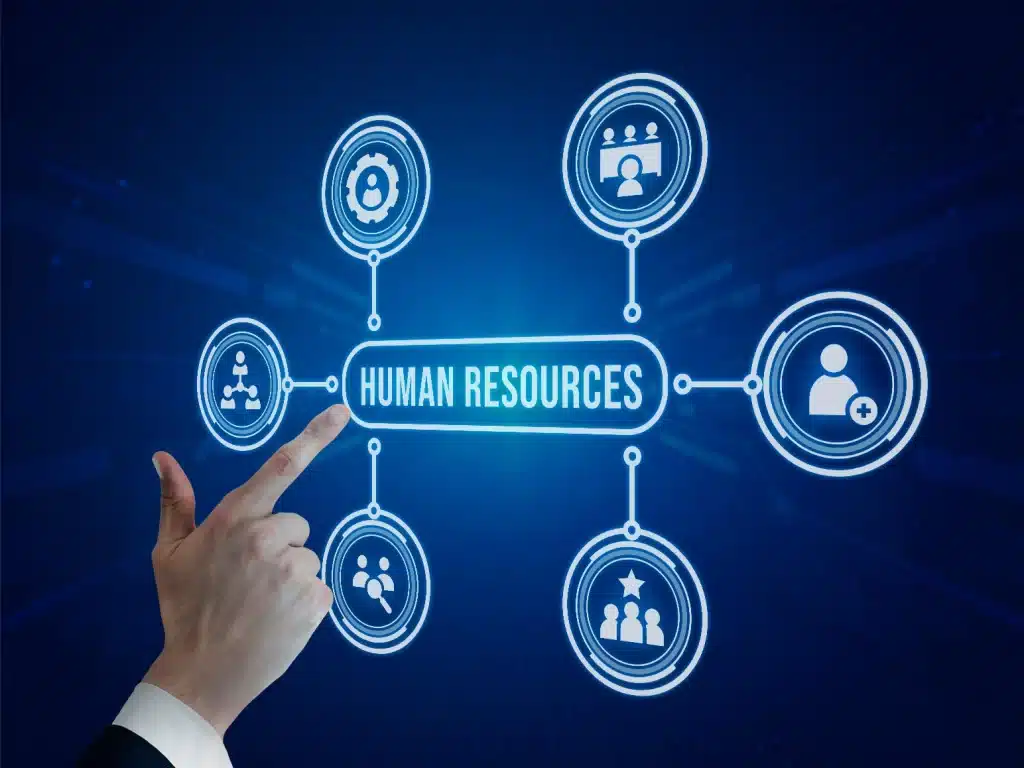In this article, you will learn about the importance of HR technology strategy for the companies and understand how to build a flexible strategy

Creating Productive HR Technology Strategy: Navigating the Future of Work
The article aims to highlight the importance of developing a robust HR technology strategy. It discusses the benefits that organizations can reap by embracing modern HR technology and the potential pitfalls of not having a well-defined strategy. The article also offers insights into how to create and implement an effective HR tech strategy.
Introduction
A well-defined Human Resources (HR) technology strategy holds significant importance in today's business landscape. It serves as a roadmap for integrating technology solutions to streamline HR processes and enhance overall organizational performance. By aligning HR technology with business goals, this strategy helps optimize workforce management, improve employee experience, and boost operational efficiency.
Without a proper HR tech strategy, organizations can face a range of challenges. Firstly, there might be disjointed and manual processes leading to inefficiencies and errors in tasks such as recruitment, onboarding, and payroll. This can result in higher operational costs and reduced productivity. Secondly, the lack of a coherent strategy could lead to poor data management and hinder data-driven decision-making, impacting strategic workforce planning and performance analysis.
Additionally, without a clear HR tech strategy, organizations may struggle to adapt to changing compliance and regulatory requirements, leading to legal risks and penalties. Besides, 80% of HR leaders say they will invest in new recruitment technologies.
The absence of a strategy might also hinder employee engagement and development, as it becomes difficult to offer personalized learning opportunities and career growth paths. Moreover, the lack of integrated systems can hamper communication and collaboration among teams, affecting overall organizational cohesion.
Ultimately, the absence of a well-defined HR technology strategy can hinder an organization's ability to attract, retain, and develop top talent, stifling its competitiveness and growth prospects in today's technology-driven business environment.
Need help in implementing HR technology services? Our software development team is ready to help you at every stage of the project lifecycle.

Importance of HR Technology Strategy
Technology has significantly transformed the way HR functions operate. From recruitment and employee onboarding to performance management and payroll processing, various HR functions are now heavily reliant on technology. HR technology can streamline processes, enhance efficiency, and provide valuable data-driven insights.
Alignment with Business Goals: An effective HR technology strategy aligns with an organization's overall business goals. By integrating technology solutions that cater to HR needs, businesses can ensure that their workforce is equipped with the tools they need to perform at their best. This alignment helps to foster a more productive and engaged workforce. Now, let’s look at some benefits of a well-defined strategy.
Cost Efficiency
Implementing an HR technology strategy can lead to cost savings in the long run. By automating manual processes and reducing paperwork, organizations can optimize their HR operations and allocate resources more efficiently. Additionally, well-implemented technology can minimize errors and compliance risks, further reducing potential costs.
Improved Time Management
HR teams often spend a significant amount of time on administrative tasks. A well-defined technology strategy can automate routine tasks such as data entry, leave management, and timesheet tracking. This automation frees up HR professionals to focus on strategic activities such as talent development and employee engagement.
Accurate Insights
Data is a valuable asset in modern HR practices. A technology strategy enables the collection and analysis of HR data, providing insights into workforce trends, performance metrics, and employee satisfaction. These insights help HR teams make informed decisions and develop strategies for talent acquisition, retention, and overall organizational improvement.
HR technology strategy is crucial for leveraging the benefits of technology to enhance HR operations and align them with broader business objectives. By streamlining processes, improving efficiency, and harnessing data-driven insights, organizations can create a more effective and agile HR function that contributes to the overall success of the company.
Laying the Groundwork for HR technology strategy
Laying the groundwork for an effective HR technology strategy involves assessing the organization's current HR processes and identifying areas that could benefit from technological solutions. This requires close collaboration between HR professionals and IT experts to align technology initiatives with HR goals. Additionally, a clear roadmap outlining the implementation, training, and ongoing evaluation of chosen technologies is essential for successful adoption and continuous improvement.
Stakeholder Involvement
Stakeholder involvement is paramount when developing an HR tech strategy. Firstly, engaging HR leaders ensures alignment with overarching organizational goals and HR functions. Secondly, involving IT personnel helps assess the technical feasibility and integration capabilities of the proposed technology solutions. Thirdly, input from end-users, such as employees and managers, ensures that the technology meets their practical needs and addresses pain points. Additionally, finance representatives' participation is vital for budget considerations and cost-effective technology investments. Lastly, obtaining input from senior management guarantees strategic support, resource allocation, and the integration of the HR tech strategy with the overall business roadmap. Involving these stakeholders fosters a holistic approach that increases the chances of successful implementation and adoption of HR technology solutions.
Importance of Involving HR, IT, and Business Leaders:
Let’s also look at why it’s important to involve HR, IT, and business leaders:
Alignment of Goals
HR, IT, and business leaders bring diverse perspectives to the table. Involving them ensures that the HR technology strategy is aligned with the overall business goals and IT capabilities.
Technical Feasibility
IT leaders can provide insights into the feasibility of implementing certain technologies. Their expertise ensures that the chosen solutions can be integrated with existing systems and infrastructure.
User-Centric Design
HR leaders understand the needs of employees and can provide input on user experience design. This results in technology solutions that are user-friendly and cater to employee requirements.
Change Management
Business leaders can provide insights into how technology changes might impact the organization's culture and workforce. Their involvement can facilitate smoother change management processes.
Resource Allocation
Collaboration between stakeholders helps allocate resources effectively. Business leaders can prioritize initiatives based on business value, and IT leaders can assess resource availability for implementation.
Case Studies on Successful Stakeholder Involvement
Let’s look at companies with successful stakeholder involvement.
Case Study 1: IBM's HR Transformation
IBM embarked on a comprehensive HR transformation journey to modernize its HR processes and technologies. The company engaged HR, IT, and business leaders in a collaborative effort. The HR team provided insights into employee pain points, IT leaders ensured technical compatibility, and business leaders aligned the strategy with business objectives. This collaborative approach resulted in a streamlined HR technology landscape that improved employee self-service, reduced administrative burden, and aligned HR with business goals.
Case Study 2: Procter & Gamble's Digital HR Strategy
Procter & Gamble (P&G) recognized the need to leverage technology for HR efficiency and effectiveness. The company brought together HR, IT, and business leaders to co-create a digital HR strategy. By involving IT leaders early on, P&G ensured that the chosen technologies aligned with the existing IT infrastructure. HR leaders provided insights into the specific needs of the workforce. The resulting strategy led to the implementation of self-service portals, data analytics for talent management, and AI-powered recruitment tools, enhancing both HR and business outcomes.
So, involving HR, IT, and business leaders in the development of an HR technology strategy is crucial for its success. These stakeholders bring diverse expertise and perspectives that contribute to a well-rounded strategy aligned with business goals and technical feasibility. The presented case studies demonstrate the positive outcomes of such collaborative efforts.
Understanding Business Goals
Understanding business goals is crucial in HR tech transformation as it aligns technology implementation with overarching organizational objectives. By comprehending these goals, HR tech solutions can be tailored to enhance efficiency, employee experience, and strategic decision-making. This alignment ensures that technology is not implemented for its own sake, but rather as a tool to address specific business challenges, such as talent acquisition, performance management, or workforce analytics. Ultimately, linking HR tech transformation to business goals fosters a more productive and competitive workplace.

Aligning HR tech strategy with organizational objectives
Aligning HR tech strategy with organizational objectives involves a meticulous assessment of the company's goals and challenges. This assessment should inform the selection and implementation of technology solutions that streamline HR processes, enhance employee experience, and foster overall business growth. By ensuring that HR tech investments directly address the organization's needs, from talent acquisition and development to performance management, companies can achieve higher operational efficiency, increased employee engagement, and ultimately, a more competitive edge in the market. Regular reviews and adjustments to the HR tech strategy based on evolving organizational objectives are essential to maintain this alignment over time.
Conducting interviews with stakeholders
Conducting interviews with stakeholders in HR tech strategy is a pivotal process in understanding the intersection of technology and human resources. These interactions provide insights into the organization's current technology landscape, its alignment with HR goals, and potential areas for improvement. Engaging with stakeholders also enables the identification of challenges, opportunities, and user needs, fostering the development of a robust and tailored HR tech strategy that can drive organizational success. Through these interviews, a comprehensive picture emerges, guiding the formulation and implementation of effective tech-driven HR solutions.
Strategy Development
Strategy development involves a comprehensive analysis of an organization's HR needs, existing technology infrastructure, and future goals. By aligning these elements, businesses can craft a tailored strategy that optimizes HR processes and workforce management. The strategy formulation process often includes identifying key technology solutions, assessing their integration feasibility, and creating a roadmap for implementation and continuous refinement.
Involving HR in Strategy Creation
Human Resources (HR) plays a pivotal role in drafting and implementing organizational strategy. First, HR collaborates with leadership to align HR policies and practices with the strategic goals, ensuring that the workforce supports the intended outcomes. Second, HR assesses the existing talent pool, identifying skill gaps and creating plans for recruitment, training, and development to fulfill strategic needs. Third, HR facilitates communication between management and employees, conveying the strategy's importance, goals, and progress, thereby fostering a cohesive and motivated workforce. Fourth, HR monitors and analyzes key performance metrics, providing data-driven insights to refine and adjust the strategy as necessary. Fifth, HR ensures that the organizational culture and values are integrated into the strategy, enhancing employee engagement and commitment to its successful implementation.
Effective HR strategy necessitates collaboration with IT and other departments to thrive. IT ensures seamless implementation of digital HR solutions, optimizing processes like employee onboarding and data management. Collaborating with various departments ensures alignment of HR initiatives with overall organizational goals, fostering a productive and harmonious work environment.
Customization to Business Goals
Customization plays a pivotal role in aligning HR tech strategy with business goals. By tailoring technological solutions to the unique needs of the organization, HR can effectively address specific challenges and optimize processes. This entails configuring HR software to streamline recruitment, training, and performance management in a way that directly supports the company's growth objectives. Such customization enhances efficiency, promotes employee engagement, and ultimately contributes to the attainment of strategic business goals. And here are some real-world examples:
- IBM: IBM leveraged AI-powered chatbots to enhance its HR services. Employees can now get quick responses to HR-related questions, allowing HR professionals to focus on more strategic tasks.
- Siemens: Siemens implemented a digital HR platform that streamlined various HR processes. This move significantly reduced administrative workload and improved overall HR efficiency.
- Unilever: Unilever used VR technology for training and development. New employees experience virtual scenarios that mimic real work situations, enhancing learning outcomes.
- Deloitte: Deloitte utilized predictive analytics to identify potential high-performing employees and predict turnover risks, enabling them to take proactive measures to retain top talent.
Remember, each organization is unique, so the HR tech strategy should be customized to address specific challenges and goals. Regular reviews and adjustments are crucial to maintaining alignment with evolving business needs.
Flexibility and Adaptability
In a rapidly evolving technological landscape, HR tech must be designed to accommodate changes seamlessly. This involves scalable infrastructure, modular software systems, and agile processes that can be adjusted to meet shifting organizational needs. By prioritizing flexibility and adaptability, companies can future-proof their HR tech solutions, ensuring they remain effective and relevant in the face of evolving business and technological requirements.
Building a Flexible Strategy
In the realm of HR tech strategy, building adaptability is paramount due to the rapid evolution of technology and its impact on the workforce. An adaptable strategy ensures that an organization can effectively respond to unforeseen changes, seize new opportunities, and remain competitive in the dynamic landscape of HR technology. As technological advancements continue to reshape traditional HR processes, having a flexible strategy becomes the cornerstone of sustainable growth and success.
To assess and update your HR tech strategy for maximum adaptability, consider these steps:
First, regularly monitor industry trends and emerging technologies to stay ahead of the curve. This involves conducting thorough research, attending conferences, and engaging with thought leaders to understand the direction in which the field is heading.
Second, establish key performance indicators (KPIs) that are aligned with your organization's goals and can be adjusted in response to changing circumstances. This allows you to measure the effectiveness of your strategy and make data-driven decisions.
Third, foster a culture of experimentation within your HR tech team. Encourage them to explore innovative solutions, test new technologies, and learn from failures.
Fourth, maintain open lines of communication with all stakeholders, including employees, management, and IT teams. This ensures that insights from various perspectives are considered when adapting the strategy.
Fifth, prioritize scalability and interoperability when selecting HR tech solutions. An adaptable strategy should accommodate seamless integration of new tools and systems as your organization grows.
Sixth, conduct regular strategy reviews to assess its relevance and effectiveness. These reviews should involve a comprehensive analysis of successes, challenges, and opportunities encountered while executing the strategy.
Seventh, be prepared to pivot and make changes swiftly when necessary. If market conditions or internal dynamics shift significantly, your strategy should have provisions for quick adjustments.
Lastly, invest in continuous learning and skill development for your HR tech team. A well-trained team is better equipped to handle evolving technologies and contribute to the strategy's adaptability.

Long-Term Perspectives
Developing a long-term HR tech strategy requires a comprehensive approach that aligns with evolving workforce trends and technological advancements. This involves continually assessing the organization's HR needs, integrating adaptable and scalable technology solutions, and fostering a culture of digital readiness among employees. To ensure success, the strategy should prioritize data security, privacy, and ethical considerations, while also remaining flexible enough to accommodate unforeseen shifts in both HR practices and technological landscapes.
Incorporating talent management and enhancing employee effectiveness are pivotal aspects of a comprehensive HR tech strategy that extends beyond mere automation. Such a strategy recognizes that technology can not only streamline processes but also elevate the human-centric elements of HR. By leveraging data-driven insights from HR tech tools, organizations can make informed decisions about talent acquisition, development, and retention, ultimately fostering a more agile and competitive workforce. This approach acknowledges that while automation can handle routine tasks, it's the strategic utilization of technology in tandem with a focus on talent that truly drives organizational success. Employee engagement, skill enhancement, and career growth become central pillars in this strategy, leading to a more holistic and impactful HR function.
Check out our article on software development team structure.
Implementation and Execution
Implementation and execution are critical stages in an HR tech strategy. The implementation phase involves translating the strategic plan into actionable steps, such as selecting the appropriate HR technologies, customizing them to fit the organization's needs, and integrating them with existing systems. Effective execution entails deploying these technologies across the organization, ensuring proper training and change management, and continuously monitoring and optimizing their performance to achieve the desired outcomes. This iterative process helps organizations enhance their HR functions, streamline processes, and improve overall employee experiences.
Timeline and Budget
Creating a comprehensive HR technology strategy involves several stages and considerations. Initially, a thorough assessment of the current HR processes and systems is conducted, which usually takes around 2-3 weeks. Subsequently, a detailed strategy, including technology recommendations and implementation plans, is developed over the following 4-6 weeks. The strategy is then presented to key stakeholders for feedback and refinement, which can take an additional 2-3 weeks. Once approved, the implementation phase begins, with a budget allocation that depends on the complexity of the systems and the scale of the organization. Overall, the timeline for the entire process, from assessment to implementation, typically spans around 3-6 months.
Regarding successful resource allocation strategy in HR tech, it involves first assessing the organization's current technology infrastructure and identifying areas for improvement. This includes understanding the specific HR functions that can benefit from technology optimization, such as recruitment, talent management, or employee engagement. Next, prioritize investments based on their potential impact on HR processes and overall business goals, ensuring alignment with the company's long-term strategic objectives. Additionally, consider factors like scalability, data security, and user-friendliness when selecting and implementing HR tech solutions. Regular monitoring and adjustment of the resource allocation strategy are essential to adapt to evolving HR technology trends and organizational needs.
Employee Expectations
Employee expectations in HR tech strategy have evolved significantly in recent years. Today, employees expect user-friendly and intuitive HR tech solutions that streamline their daily tasks and provide self-service options for tasks like time tracking, leave requests, and benefits management. They also anticipate mobile accessibility to HR tools, enabling them to access information and complete tasks on the go. Data privacy and security are paramount, with employees expecting their personal information to be safeguarded within the HR tech ecosystem. Lastly, they anticipate HR tech to offer advanced analytics and reporting capabilities, allowing them to access insights about their own performance and career growth opportunities within the organization.
To ensure a smooth transition for employees, proper change management protocols should be in place. This includes clear communication about the purpose and benefits of the new technology, as well as providing training and support to help employees adapt. HR tech implementation should be phased, allowing employees to gradually acclimate to the changes.
Training and development are integral components of this strategy. HR tech should offer accessible and relevant training resources to help employees upskill and adapt to new tools and processes. Regular updates and continuous learning opportunities should also be integrated into the tech platform, ensuring that employees can continually enhance their skills and remain competitive in the workplace.
Measuring Success
Measuring success in HR development strategy involves assessing several key performance indicators (KPIs) to ensure the effectiveness of talent development initiatives. These KPIs may include employee retention rates, skill development and training program effectiveness, employee engagement scores, and succession planning outcomes. Additionally, monitoring the alignment of HR development efforts with organizational goals and the overall impact on the company's bottom line is crucial for determining success. Ultimately, a successful HR development strategy should lead to a more skilled, engaged, and productive workforce, contributing positively to the company's overall performance and growth.
Key Performance Indicators (KPIs)
Key Performance Indicators (KPIs) are essential in evaluating the success of an HR development strategy. Here are some key metrics to track:
Employee Engagement
Measure employee satisfaction and engagement through surveys and feedback mechanisms to gauge the strategy's impact on workforce morale and commitment.
Turnover Rate
Monitor turnover rates to assess whether the strategy is retaining talent effectively or if there are issues that need addressing in terms of employee retention.
Skill and Competency Development
Track the progress of employees in acquiring new skills and competencies, whether through training programs or on-the-job learning.
Promotion Rates
Analyze how frequently employees are being promoted, indicating the effectiveness of the strategy in fostering career growth and internal mobility.
Training and Development Costs
Evaluate the costs associated with training and development initiatives to ensure they are within budget and delivering a favorable return on investment.
Time-to-Fill Positions
Measure how long it takes to fill vacant positions, as a shorter time indicates an effective strategy for talent acquisition and succession planning.
Diversity and Inclusion Metrics
Assess the strategy's impact on diversity and inclusion by tracking metrics like the representation of underrepresented groups in leadership positions.
To evaluate the success of the HR development strategy, consider these steps:
- Set Clear Goals: Establish specific, measurable, achievable, relevant, and time-bound (SMART) goals at the outset of the strategy. These goals will serve as benchmarks for success.
- Regular Data Analysis: Continuously collect and analyze the relevant KPI data to monitor progress over time. Regularly review trends and patterns.
- Benchmarking: Compare your organization's KPIs with industry benchmarks and competitors to gain insights into your strategy's relative performance.
- Feedback and Surveys: Solicit feedback from employees and managers to understand their perceptions of the strategy's impact on their development and the organization's success.
- Adjustment and Adaptation: Be prepared to make adjustments to the strategy based on the data and feedback received. Flexibility is key to improving results.
- Financial Impact: Assess the financial impact of the strategy by calculating the ROI of HR development initiatives. Evaluate the cost-effectiveness of training and development efforts.
- Long-term Impact: Consider the long-term effects of the strategy by tracking the progression of employees over their careers, as well as the organization's overall growth and stability.
Evaluating the success of an HR development strategy is an ongoing process that requires a combination of quantitative and qualitative data analysis, employee input, and a commitment to continuous improvement. Adjustments and refinements should be made as needed to ensure that the strategy aligns with the organization's goals and objectives.

How to create HR software?
According to the Grand View Research, a 13% growth rate in the market for talent management tools is anticipated, - and it means that it’s important to embrace the change now. Creating HR software involves several steps, including defining the software's objectives, designing user-friendly interfaces, integrating essential HR functionalities like payroll, attendance tracking, and employee management, and ensuring data security and compliance with relevant regulations. Additionally, it's crucial to continuously gather feedback from HR professionals and end-users to refine and improve the software's features and usability over time.
Check out our article on HRM software development.
Finding the team
When seeking a team for outsourcing or IT staffing to support your HR tech strategy, it's crucial to first define your specific requirements and goals. Identify the key areas of HR technology you want to focus on, such as payroll, recruitment, or employee management systems. Next, consider partnering with a reputable outsourcing firm or staffing agency that specializes in HR tech solutions. Look for a team with a proven track record in implementing similar projects and a deep understanding of the HR industry's unique challenges. Finally, ensure that the team you choose has the technical expertise and cultural fit to seamlessly integrate with your organization's HR department and overall business strategy.
Project estimation
Estimating the timeline and resources required for a Human Resources (HR) technology strategy project is essential for effective planning. This process involves assessing the scope of the project, including the specific HR tech solutions to be implemented and their integration requirements. Accurate estimation also considers the availability of skilled HR professionals and IT resources, as well as potential challenges such as data migration or change management efforts. It's crucial to engage key stakeholders and subject matter experts to gather insights and refine the project estimate. Regular monitoring and adjustment of the estimate throughout the project's lifecycle can help ensure it stays on track and within budget.
Implementation schedule
The implementation schedule for an HR development strategy typically involves several key phases and milestones. Firstly, the planning phase should span 1-2 months to identify specific HR development goals and align them with organizational objectives. The next phase, which includes designing training programs and resources, should take 2-3 months. Implementation itself, where training is delivered and development initiatives are put into action, may last 6-12 months or longer depending on the complexity. Ongoing monitoring and evaluation should be conducted throughout, with regular checkpoints and assessments every 3-6 months to ensure the strategy's effectiveness and make necessary adjustments. Lastly, a comprehensive review and revision of the HR development strategy should occur annually to keep it aligned with evolving business needs.
Conclusion
In conclusion, an effective HR development strategy is paramount for the success and growth of any organization. By investing in the development of their human capital, businesses can enhance employee satisfaction, productivity, and retention. Furthermore, a well-planned HR development strategy ensures that the workforce is equipped with the necessary skills and knowledge to adapt to evolving industry trends and technologies. This not only fosters innovation but also maintains a competitive edge in the market. Ultimately, a forward-thinking HR development strategy is an invaluable asset that positions companies for long-term success in a rapidly changing business landscape.
you may also want to read

Leveraging Local LLMs and Secure Environments to Protect Sensitive Information
In the rapidly evolving digital landscape, businesses are increasingly adopting Generative AI (GenAI) technologies to stay competitive and innovate. Large...

Boost Efficiency Today: Easy AI Integration for Immediate Results
In the past, the idea of integrating artificial intelligence into your business might have felt like venturing into uncharted territory—complex,...

A Roadmap to Gen AI Adoption for Small and Medium Businesses
Unlock new opportunities by integrating Generative AI into your business operations. In today’s fast-paced digital landscape, small and medium businesses...
